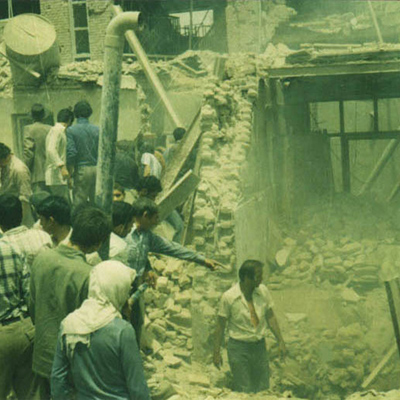Sites
Dezful
Written by: Emad Ezatabadi
Translated by: Hadi Qorbanyar
99 Views
Dezful is a city in Khuzestan Province that, during the eight years of the Iran–Iraq War, was repeatedly targeted by Iraqi air raids, missile strikes, and artillery fire.
Dezful, the capital of Dezful County in Khuzestan Province, is located 165 kilometers north of Ahvaz.[1] Geographically, it is located where the Zagros Mountains meet the Khuzestan Plain, with the Dez River flowing through the city.[2] Dezful experiences a mild winter climate, whereas from mid-spring through November, the temperature rises significantly, sometimes accompanied by dust storms.[3]
During the Sassanid era, a bridge was constructed over the Dez River, and later, a military fortress was built on its western side. Over time, as the cities of Shush and Gundeshapur lost their prominence, people migrated to this fortress, which gradually expanded and developed into the city of Dezful.
The original name of the city was Dezhpul, but after the Islamic period, it was renamed Dezful, as the Arabic language does not have the sounds ‘p’ and ‘zh’.[4] At the time of the 1986 national census, the city’s population was over 239,000, most of whom were engaged in industry, agriculture, and services.[5]
In 1956, initial preparations began for the construction of the Dez Dam and hydroelectric power plant, located 25 kilometers northeast of Dezful. This eventually led to the building of the tallest dam in the Middle East and the sixth-largest in the world at the time.[6] One year later, construction began on an air base near the city in the Tappeh Charmi area, later known as Vahdati Air Base (1961).[7]
Before the outbreak of the Iran–Iraq War, the Islamic Revolutionary Guard Corps (IRGC) of Dezful was involved in operations against the anti-revolutionary groups (Komala) and the Democratic Party of Iranian Kurdistan in the western regions of the country, a mission that continued until the start of the war.[8] When Iraq invaded Iran on September 22, 1980, southern Iranian cities came under bombardment. Therefore, volunteers from Dezful, Shush, and Andimeshk—under the command of the Dezful IRGC—joined other Army forces in countering the enemy. The 7th Vali-e Asr (as) Division, formed by Dezful IRGC forces, participated in 14 major operations during the eight-year war with its 38 battalions.[9]
On September 22, 1980, the Vahdati Air Base in Dezful was targeted for the first time by Iraqi MiG fighters, resulting in the martyrdom of two civilians and one military officer.[10] The civilians martyred in this attack were Hussain Lavafian and Reza Pirzadeh-Sanjari, and the serviceman was pilot Firooz Sheikh-Hussaini, the base’s safety officer.
On September 24, enemy aircraft targeted military installations near Vahdati Air Base. This caused gravel to scatter across the runway, preventing the stationed F-5 jets from launching operations. However, the people of Dezful rushed to the base, cleared the runway, and made it possible for the operation to be carried out as planned.
On September 27, 1980, after Iraqi forces advanced by capturing Shavurieh and the Ali-Ghereh-Zad Heights east of Dasht-e Abbas and approached the city, Dezful came under artillery fire for the first time. This marked the beginning of Saddam’s bombardments of the city.
A week later, residential areas of Dezful were targeted by enemy airstrikes for the first time, leaving 18 martyred and 64 injured. The attacks were repeated on October 4 and October 7. Then, on October 8, 1980, Dezful was struck by Iraq’s Frog-7 missiles.[11] This was the first time since World War II that a city was targeted by missile attacks.[12] In this strike, 105 people were martyred and 300 were injured, causing some of the population to leave the city for safer areas.
The following day, Iraqi aircraft once again bombed Dezful, but one of them was shot down by Iranian air defenses. Iraq’s second and third missile attacks on Dezful that took place on October 15 and October 21, 1980, failed to hit the city.[13] However, on October 26, Dezful was hit by multiple missile strikes, resulting in the martyrdom of 100 people and injuries to 250 others.[14]
The enemy’s extensive attacks on Dezful and the need to protect civilian lives led the Iranian officials to restore and expand traditional underground shelters known as “Shavadun”. These were deep, flat underground basements accessed by 15 to 20 steps; their entrances, 2 to 2.5 meters wide, were connected by underground passageways called “Taal”.[15] In order to reduce casualties and enable rapid repairs of damage, the city authorities launched a campaign encouraging people to construct Shavadun while also organizing the available local forces. At night, electricity was cut off to prevent enemy aircraft from spotting the city. In addition, the Vahdati Air Base was responsible for securing Dezful’s airspace.[16]
On November 6, 1980, Radio Dezful began broadcasting and remained active until 1982. In cooperation with the Dezful Governor’s Office and the 4th Tactical Air Base of the Iranian Army Air Force, a system was set up to enhance early warning capabilities. As soon as the base’s radar detected enemy aircraft or ground-to-ground missiles, it would immediately notify the local radio station via a dedicated telephone line, which would announce a red alert.[17]
During the war, Radio Dezful expanded its services to cover northern Khuzestan,[18] and it remains operational to this day.
On March 16, 1982, the Dezful Governor’s Office established the War Support Headquarters to coordinate logistical support for the Iranian troops.[19]
Throughout 1982, the city remained under artillery fire and airstrikes, while missile attacks were intensified to such an extent that out of 107 missile-strike martyrs recorded nationwide, 96 were from Dezful.[20]
On March 22, 1982, following Iran’s success in Operation Fath al-Mubin west of Dezful, the city was finally removed from the range of Iraqi artillery fire. However, on October 26 of the same year, the first Iraqi Scud missile struck Dezful, resulting in the martyrdom of 135 people. On December 19, 1982, two more missiles hit heavily populated areas of the city, destroying 200 houses and shops, and leaving 62 civilians martyred and 287 others injured.[21]
In 1983, nine missile attacks were recorded against the city, including the October 22 strike on Dezful’s Grand Mosque, in which 57 civilians were martyred and 695 were injured.[22]
The missile attacks escalated in late 1984 and early 1985. On February 11, 1985, alone, five missiles struck Dezful, destroying many homes, a primary school, and a hospital, and causing heavy casualties. In addition, on March 7, eight missiles were simultaneously launched against the city, resulting in the martyrdom of 19 individuals, injuries to 66 others, and the destruction of hundreds of homes and shops.[23]
On February 2, 1986, Ayatollah Seyyed Mojtaba Qazi Dezfuli, the representative of Imam Khomeini (ra), passed away. He had long stood as an influential figure in the city’s struggle. In critical moments, he never abandoned Dezful, refusing even to take shelter in his own Shavadun during missile strikes, and remained steadfast alongside the people and fighters throughout the most difficult days of the war.[24]
On August 16, 1986, an Iraqi Mirage aircraft attacked the Dez Dam facilities, causing minor damage. On its way back, this fighter jet was shot down by an Iranian anti-aircraft system.[25] On September 25 of the same year, enemy aircraft broke the sound barrier over the city, and on October 5, they attacked an industrial unit, resulting in the martyrdom of one person and the injury of fifteen others.
The peak of enemy attacks on Dezful was reached in January 1987, when, in retaliation for its defeat in Operation Karbala 5, the enemy intensified its missile and air assaults on the city on January 11 and again from January 14 to January 20.[26]
On May 25, 1987, in recognition of the resilience of Dezful’s people in the face of enemy attacks, a ceremony was held with the participation of state and military officials as well as local residents. During the event, a golden memorial was installed at the Fath al-Mubin Square in Dezful. Since then, this date has been formally recognized in Iran’s calendar as the “Day of Resistance and Endurance – Day of Dezful”.[27]
On August 19 and 21, 1987, enemy strikes on the Haft-Tappeh Workers’ Complex left a large number of workers martyred and injured.[28] On September 9, the Dezful sugar factory was also targeted in an air raid.[29] Likewise, on March 10, 1988, the Omid School in Dezful was bombed by the enemy, leading to many student injuries and partial destruction of the school.[30]
The last airstrike on Dezful during the imposed war took place on July 15, 1988, when Iraqi cluster bombs led to the martyrdom of two young girls,[31] aged ten and three.[32]
Over the course of 2,700 days of resistance, Dezful was targeted 176 times by missiles, 489 times by bombs and rockets, and 2,500 times by artillery shells.[33] A total of 2,600 individuals from Dezful were martyred, 4,000 were wounded, 452 were taken prisoner, and 147 went missing in action during the imposed war, testifying to the city’s unwavering commitment to Islam and the Revolution.[34]
In April 2002, the air division of the “Rahian-e Noor” caravans was established at Vahdati Air Base in Dezful in commemoration of the heroic role of the Iranian Army Air Force.[35] After the imposed war, several memorials were built throughout the city to honor the resistance of its people. Among them are the “Unidentified Martyrs Memorial” on Rudaki Street, “Resistance Square” or “Missile Square” near Rasul Azam (pbuh) Mosque, and the “Alef Memorial” near the Karnasian Bathhouse, which recalls the missile threats Dezful faced during the Sacred Defense.[36]
Publications on Dezful include Alef Dezful (A Dezful) by Abdolreza Saleminejad (Avan-e Jonoub Publication), Shabhaye Moshak-baran (Nights of Missile Attacks) by Azim Mahmoudzadeh Shirazi and Abdolrahim Saeedi (Avan-e Jonoub Publication), and Khotbeh-haye Moqavemat (Sermons of Resistance), a collection of Friday Prayer sermons delivered by the late Ayatollah Ghazi Dezfuli, the city’s Friday prayer leader, compiled by Saeed and Muhammad-Hussain Durchin (Sarv-e Dana Publication).
[1] Zaman-Rashidian, Nayyereh, Negahi be Tarikh-e Khuzestan (A Look at the History of Khuzestan), Tehran, Nashr-e Bouali, 1st ed., 1367, p. 112.
[2] Saleminejad, Abdolreza, Dezful: Gozareshi az Shahr-e Moqavam-e Dezful dar Jang-e Shahrha 1359-1367 (Dezful: A Report on the Resistant City of Dezful during the City Warfare 1980–1988), Tehran, Sepah-e Pasdaran-e Enqelab-e Eslami, Markaz-e Asnad va Tahqiqat-e Defa Muqaddas, 1397, p. 26.
[3] Zaman-Rashidian, Nayyereh, Ibid., p. 191.
[4] Ibid., Pp. 114–116.
[5] Saleminejad, Abdolreza, Ibid., Pp. 27–28.
[6] Zaman-Rashidian, Nayyereh, Ibid., p. 118.
[7] Mahname-ye Sanaye-e Havaei (Sanaye-e Havaei Monthly), Year 21, No. 249, Ordibehesht 1391, p. 46.
[8] Ibid., p. 16.
[9] Ibid., p. 10.
[10] Latifpour, Ahmad, Dezful Dezh-e Ostovar: Ruzshomar-e Hamalat-e Havaei, Toopkhanei va Mushaki be Shahr-e Moqavam-e Dezful dar Hasht Sal Defa Muqaddas (Dezful, the Sturdy Fortress: Chronology of Air, Artillery, and Missile Attacks on the Resistant City of Dezful during the Eight Years of Sacred Defense), Tehran, Nashr-e Nilufaran, 1396, p. 15.
[11] Latifpour, Ahmad, Ibid., Pp. 21, 28, 30, 32, 33.
[12] Saleminejad, Abdolreza, Ibid., p. 153.
[13] Latifpour, Ahmad, Ibid., Pp. 49-50.
[14] Saleminejad, Abdolreza, Ibid., p. 160.
[15] Latifpour, Ahmad, Ibid., p. 39.
[16] Saleminejad, Abdolreza, Ibid., Pp. 168, 171, 239.
[17] Latifpour, Ahmad, Ibid., p. 61.
[18] Saleminejad, Abdolreza, Ibid., p. 333.
[19] Latifpour, Ahmad, Ibid., p. 129.
[20] Ibid., p. 187.
[21] Saleminejad, Abdolreza, Ibid., Pp. 194, 195, 200, 191.
[22] Ibid., Pp. 204, 205, 209.
[23] Ibid., Pp. 223–224.
[24] Ibid., p. 185.
[25] Ibid., p. 195.
[26] Ibid., Pp. 262–263.
[27] Latifpour, Ahmad, Ibid., p. 203.
[28] Saleminejad, Abdolreza, Ibid., p. 275.
[29] Ibid., p. 274.
[30] Ibid., p. 276.
[31] Latifpour, Ahmad, Ibid., p. 224.
[32] Ibid.
[33] Saleminejad, Abdolreza, Ibid., Pp. 19, 277.
[34] Ibid., p. 19.
[35] Mahname-ye Sanaye-e Havaei (Sanaye-e Havaei Monthly), Year 23, No. 272, Farvardin 1393, p. 3.
[36] Latifpour, Ahmad, Ibid., Pp. 126, 215.





